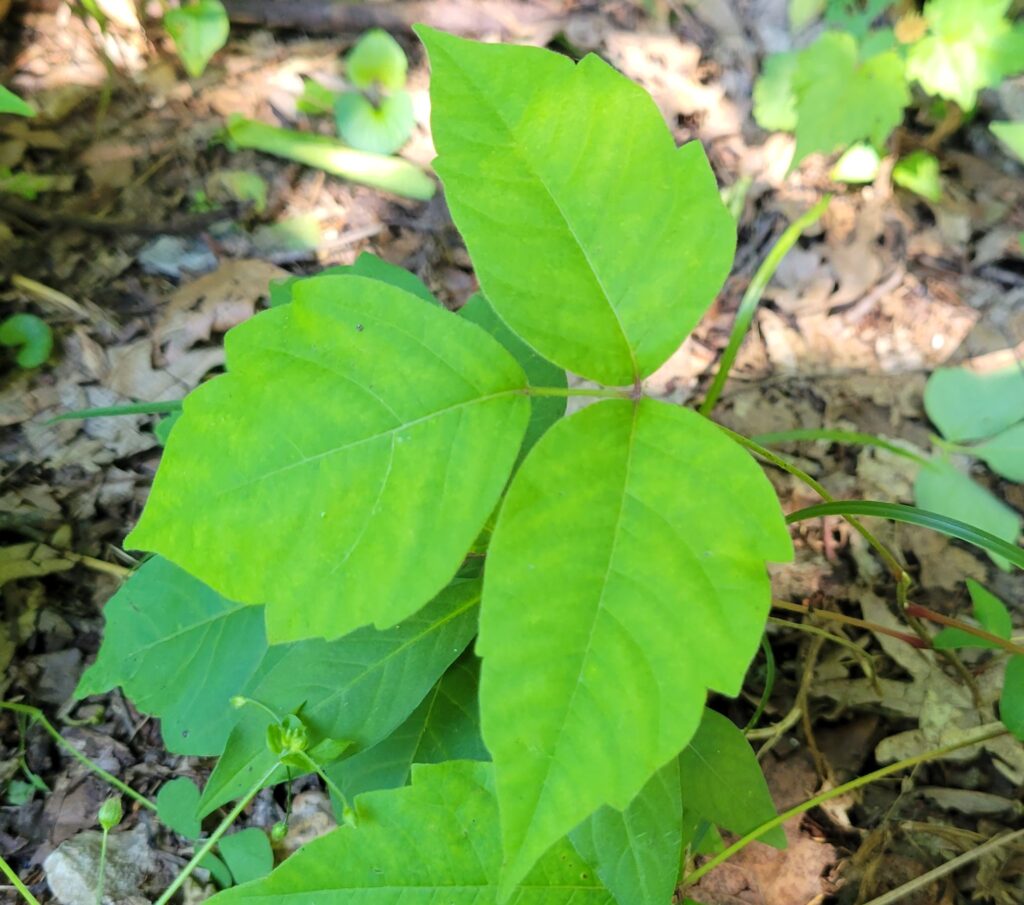We may know the rhyme “leaves of three, leave it be” by heart, but at some point we inevitably step in, brush against, or accidentally plunge our hands into poison ivy. Ouch! It is not an enjoyable experience for humans to have a stinging rash that desperately wants to be scratched. But, poison ivy is a true salad for wildlife providing valuable nutrition and shelter throughout the seasons.
Poison ivy (Toxicodendron radicans) is a member of the sumac family, which includes cashews, pistachios, and mangos. Native to Indiana, it can be found in distrubed areas like fence rows, ditches, trails, and old fields. Poison ivy is a sun-loving plant. Most of the poison ivy in the woods is actually above our heads in the tall tree canopy where there is plenty of sunlight.
Identifying the plant is something many of us were taught at a young age. Or, we had to learn it the hard way! It has three leaves: two leaves are opposite one another with a third leaf on a short stem in the middle. If you see a hairy vine covered in clusters of three leaves, it’s poison ivy too. Don’t try swinging on that vine, because all of it– vine, leaf, stem, berry, and roots– will give you rash.
The culprit in all poison ivy allergies is an oil called urushiol (pronounced yur-oo-shee-aal). Upon contact, it quickly penetrates pores and binds to the proteins in your skin cells. Itchiness and redness can start within an hour and increase in severity up to 48 hours. Allergic reactions vary from person to person, but a rash can last 10 days or more. Urushiol remains active up to five years, even after the plant may have withered and died.
If you think you have come into contact with poison ivy, immediately rinse with cool water and plenty of mild dish soap. Avoid soap with oils, it only helps spread the toxin. Hot water causes skin pores to open and allow urushiol to penetrate the skin faster. It is also a good idea to rinse any garden tools or shoes that may have touched the plant.
The juice created by crushing leaves and stems of Jewelweed (Impatiens capensis) is a traditional remedy to prevent the rash if applied soon after poison ivy contact. However, some individuals have a sensitivity to jewelweed which can cause a more severe rash. Or, they misidentify the plant and rub stinging nettles on their poison ivy rash. Double ouch!
The good news, for wildlife, is that most animals are immune to the toxin.
In the fall, poison ivy turns red and produces a white berry, hence the phrase, “berries of white, best take flight.” The highly nutritious berries are bountiful when many forest plants have already lost flowers, berries, and leaves. Birds like American robins, bobwhite quail, cedar waxwings, Eastern phoebes, tufted titmouses, cardinals and woodpeckers rely on these berries in the fall and winter.
Closer to the ground, the leaves and stems are browsed by deer, raccoons, rabbits, muskrats and even some bears. The dense cover of poison ivy patches shelter wildlife like mice and lizards. The hairy vines are highways for small critters who need to escape predators in a hurry. The plant’s flowers feed a wide variety of insects like beetles, bees, and butterflies.
Poison ivy is literally and figuratively irritating. Some call it the scourge of the summer. But, it is a critical part of the forest’s food web. It helps wildlife survive in late seasons. It is a sanctuary for critters that dash away from human footsteps. What should you do if you see leaves of three? “Tri-leafing” it alone.
Kelley V. Phillips is the Communications & Outreach Manager for Red-tail Land Conservancy. She strives to cultivate wonder in nature and action to protect it.




